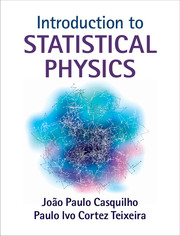Book contents
- Frontmatter
- Dedication
- Contents
- Preface
- Acknowledgements
- 1 Random walks
- 2 Review of thermodynamics
- 3 The postulates of statistical physics. Thermodynamic equilibrium
- 4 Statistical thermodynamics: developments and applications
- 5 The classical ideal gas
- 6 The quantum ideal gas
- 7 Magnetism
- 8 The Ising model
- 9 Liquid crystals
- 10 Phase transitions and critical phenomena
- 11 Irreversible processes
- Appendix A Values of some fundamental physical constants
- Appendix B Some useful unit conversions
- Index
- References
3 - The postulates of statistical physics. Thermodynamic equilibrium
Published online by Cambridge University Press: 18 December 2014
- Frontmatter
- Dedication
- Contents
- Preface
- Acknowledgements
- 1 Random walks
- 2 Review of thermodynamics
- 3 The postulates of statistical physics. Thermodynamic equilibrium
- 4 Statistical thermodynamics: developments and applications
- 5 The classical ideal gas
- 6 The quantum ideal gas
- 7 Magnetism
- 8 The Ising model
- 9 Liquid crystals
- 10 Phase transitions and critical phenomena
- 11 Irreversible processes
- Appendix A Values of some fundamental physical constants
- Appendix B Some useful unit conversions
- Index
- References
Summary
Introduction
We saw in the preceding chapter that a given physical system can be described at either the macroscopic or the microscopic level. Of course, both macroscopic and microscopic quantities correspond to the same physical reality, so they must be related. Consider, for example, the pressure exerted by a volume of gas on the walls of a container. Macroscopically, this can be measured, e.g., with a manometer or some other pressure gauge. Microscopically, we know from the kinetic theory of gases that the pressure is related to the rate of momentum transfer per unit area when the gas molecules collide with the pressure gauge. We may likewise interpret the temperature of a gas as the mean translational kinetic energy of its molecules. Therefore, if we are able to interpret macroscopic quantities in microscopic terms, then we must also be able to cast the laws of thermodynamics in the language of statistical mechanics. This is what is known traditionally as statistical thermodynamics. More modernly we speak of statistical physics, to emphasise the greater generality of its methods and their applicability to problems such as magnetism and blackbody radiation, which we shall encounter in later chapters.
The laws of classical mechanics can, under certain conditions, be applied to the motion of atoms and molecules in a gas. Suppose we wish to calculate some properties of a monatomic gas kept at room temperature and atmospheric pressure. To a good approximation, classical mechanics may be used to describe the present state of the system and its time evolution, once the present state of each particle (in this case classically distinguishable atoms) is known. On the microscopic level, the state of such a gas is specified by the position coordinates, x, y and z, and the components of the velocity, vx, vy and vz (or, equivalently, the components of the linear momentum px, py and pz) of each constituent atom at every instant in time.
- Type
- Chapter
- Information
- Introduction to Statistical Physics , pp. 48 - 81Publisher: Cambridge University PressPrint publication year: 2014

